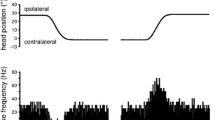Summary
The activity of Purkinje cells (P-cells) was recorded in the flocculus of alert Rhesus monkeys under different conditions of visual-vestibular stimulation. Stimulus conditions were vestibular, optokinetic, combined and conflicting. About 10–20% of all P-cells were activated in their simple spike activity during conflicting stimulation to the recording side (type I) and gave no response or much less during vestibular stimulation. About half of these P-cells were also activated during optokinetic stimulation to the recording side at velocities above 40–60 deg/s. Simple and complex spike activity behaved in a reciprocal way with overlapping but not identical working ranges. Simple spike modulation was unidirectional, complex spike activity always bidirectional. Modulation of simple spike activity cannot be related to one single parameter of the sensory input or the oculomotor output. The hypothesis is put forward that the vestibular nuclei and the flocculus behave in a complementary fashion in processing visual-vestibular information, the flocculus being specialized for high velocity optokinetic nystagmus and suppression of vestibular nystagmus.
Similar content being viewed by others
References
Barmack NH (1979) Immediate and sustained influences of visual olivo-cerebellar activity on eye movement. In: Talbott RE, Humphrey DR (eds) Posture and movement. Raven Press, New York, pp 123–168
Buettner UW, Büttner U (1979) Vestibular nuclei activity in the alert monkey during suppression of vestibular and optokinetic nystagmus. Exp Brain Res 37: 581–593
Dichgans J, von Reutern GM, Römmelt U (1978) Impaired suppression of vestibular nystagmus by fixation in cerebellar and noncerebellar patients. Arch Psychiatr Nervenkr 226: 183–199
Ghelarducci B, Ito M, Yagi N (1975) Impulse discharges from flocculus Purkinje cells of alert rabbits during visual stimulation combined with horizontal head rotation. Brain Res 87: 66–72
Ito M (1972) Neural design of the cerebellar motor control system. Brain Res 40: 81–84
Ito M (1979) Adaptive modification of the vestibulo-ocular reflex in rabbits affected by visual input and its possible neuronal mechanisms. Reflex control of posture and movement. Prog Brain Res 50: 757–761
Kato I, Kawasaki T, Aoyagi M, Sato Y, Mizukoshi K (1979) Loss of visual suppression of caloric nystagmus in cats. Acta Otolaryngol (Stockh) 87: 499–505
Keller EL, Precht W (1979) Visual-vestibular responses in vestibular nuclear neurons in intact and cerebellectomized alert cats. Neuroscience 4: 1599–1613
Lisberger SG, Fuchs AF (1978a) Role of primate flocculus during rapid behavioral modification of vestibuloocular reflex. I. Purkinje cell activity during visually guided horizontal smooth-pursuit eye movements and passive head rotation. J Neurophysiol 41: 733–763
Lisberger SG, Fuchs AF (1978b) Role of primate flocculus during rapid behavioral modification of vestibuloocular reflex. II. Mossy fiber firing patterns during horizontal head rotation and eye movement. J Neurophysiol 41: 764–777
Miles FA, Fuller JH (1975) Visual tracking and the primate flocculus. Science 189: 1000–1002
Miyashita Y (1979) Interaction of visual and canal inputs on the oculomotor system via the cerebellar flocculus. Reflex control of posture and movement. Prog Brain Res 50: 695–702
Noda H, Suzuki DA (1979a) The role of the flocculus of the monkey in saccadic eye movements. J Physiol (Lond) 294: 317–334
Noda H, Suzuki DA (1979b) The role of the flocculus of the monkey in fixation and smooth pursuit eye movements. J Physiol (Lond) 294: 335–348
Noda H, Suzuki DA (1979c) Processing of eye movement signals in the flocculus of the monkey. J Physiol (Lond) 294: 349–364
Precht W, Simpson JI, Llinás R (1976) Responses of Purkinje cells in rabbit nodulus and uvula to natural vestibular and visual stimuli. Pflügers Arch 367: 1–6
Reutern GM von, Dichgans J (1977) Augenbewegungsstörungen als cerebelläre Symptome bei Kleinhirnbrückenwinkeltumoren. Arch Psychiatr Nervenkr 223: 117–130
Robinson DA (1976) Adaptive gain control of vestibuloocular reflex by the cerebellum. J Neurophysiol 39: 954–969
Sato Y, Kato I, Kawasaki T, Mizukoshi K, Hayano M (1980) Failure of fixation suppression of caloric nystagmus and ocular abnormalities. Arch Neurol 37: 35–38
Simpson JI, Hess R (1977) Complex and simple visual messages in the flocculus. In: Baker R, Berthoz A (eds) Control of gaze by brain stem neurons: Developments in neuroscience, vol 1. Elsevier, Amsterdam New York, pp 351–360
Takemori S, Cohen B (1974) Loss of visual suppression of vestibular nystagmus after flocculus lesions. Brain Res 72: 213–224
Waespe B, Waespe W, Henn V (1980) Subjective velocity estimation during conflicting visual-vestibular stimulation. Arch Psychiatr Nervenkr 228, 109–116
Waespe W, Henn V (1978) Conflicting visual-vestibular stimulation and vestibular nucleus activity in alert monkeys. Exp Brain Res 33: 203–211
Waespe W, Büttner U, Henn V (1981a) Visual-vestibular interaction in the flocculus of the alert monkey. I. Input activity. Exp Brain Res 43: 337–348
Waespe W, Büttner U, Henn V (1981b) Input-output activity of the primate flocculus during visual-vestibular interaction. Annals New York Academy of Sciences (in press)
Zee DS (1977) Suppression of vestibular nystagmus. Ann Neurol 1: 207
Author information
Authors and Affiliations
Additional information
Supported by a grant from the Swiss National Foundation for Scientific Research 3.343-2.78
Rights and permissions
About this article
Cite this article
Waespe, W., Henn, V. Visual-vestibular interaction in the flocculus of the alert monkey. Exp Brain Res 43, 349–360 (1981). https://doi.org/10.1007/BF00238377
Received:
Issue Date:
DOI: https://doi.org/10.1007/BF00238377




